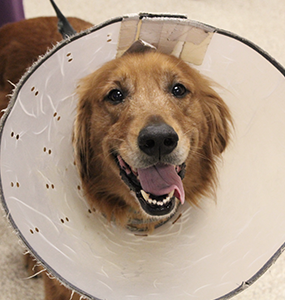Kelly Serfas, a Certified Veterinary Technician in Bethlehem, PA, contributed to this article.
Surgery and anesthesia are not exact sciences. Even the most standard surgery can lead to unexpected complications. Following your vet’s suggestions for pet care after surgery is important to ensure a successful outcome. This should at least ensure that we avoid avoidable situations. Here are five tips for post-op care.
1. Phone
It is very important to have the phone number of your family vet and your local emergency clinic (or surgeon or any other specialist) readily available. Don't ever hesitate to call if you have a question. We are there to help you and there are no silly questions when it comes to your pet's well-being.
2. Discharges
Pay close attention to the discharge instructions. Ideally, a staff member should go over them line by line with you. Ask questions; write notes; know which medication to start when; understand when you should come back for rechecks or suture removal; and be aware of what to look out for. If possible, make follow up appointments while you are at the clinic.
3. Bandages
Bandages and splints must be well cared for to prevent any severe complications. Keep them clean, dry and changed by your vet as often as they recommend. I like to change them weekly, or even more often if there is a problem. The main concern with leaving them on longer is pressure sores. Applying a good bandage is an art form as much as it is a science, so a veterinarian or experienced technician should be applying it.
 Areas surrounding splints and bandages should be checked daily for signs of irritation, swelling or wetness/dampness and reported if found. Bandages and splints should be kept dry by being wrapped in plastic when your pet is outside. However, keep them uncovered at all other times when your pet is indoors.
Areas surrounding splints and bandages should be checked daily for signs of irritation, swelling or wetness/dampness and reported if found. Bandages and splints should be kept dry by being wrapped in plastic when your pet is outside. However, keep them uncovered at all other times when your pet is indoors.
4. Confinement
Depending on the type of surgery performed, it may be critical to avoid any jumping, running, or going on furniture (including beds and sofas) and stairs. Clearly, a cat who had eyelid surgery will not need the same restrictions as a dog who had a broken bone repaired, so always follow you vet's instructions.
What is the best way to confine a pet? I hardly ever recommend crates (unless you use one large enough for a St. Bernard to confine a Chihuahua!). I typically recommend confining medium and large dogs to a small room (with no furniture) and cats and small dogs to an upside-down baby or puppy play pen. Why upside down? To prevent your pet from jumping over the top.
Confinement should be comfortable, so your pet should have a cozy bed, food, and water, in addition to a litter box for kitties.
5. Incision
Monitor the incision daily for any swelling, bruising, bleeding and oozing. Your vet or nurse should go over any specific suggestions to keep the incision dry and clean. If there is any drainage, I typically recommend using tap water and a soft cloth or paper towels to gently clean it. To prevent your pet from licking or chewing stitches, please keep the plastic cone (aka Elizabethan collar or E collar) around the clock. The stricter you are with keeping the cone on, the quicker your pet will get used to it… and everybody will keep their sanity in the meantime.
By following these 5 simple tips, you will be able to avoid 90% of the common complications we see in surgery and general practice.
If you have any questions or concerns, you should always visit or call your veterinarian – they are your best resource to ensure the health and well-being of your pets
![]()
